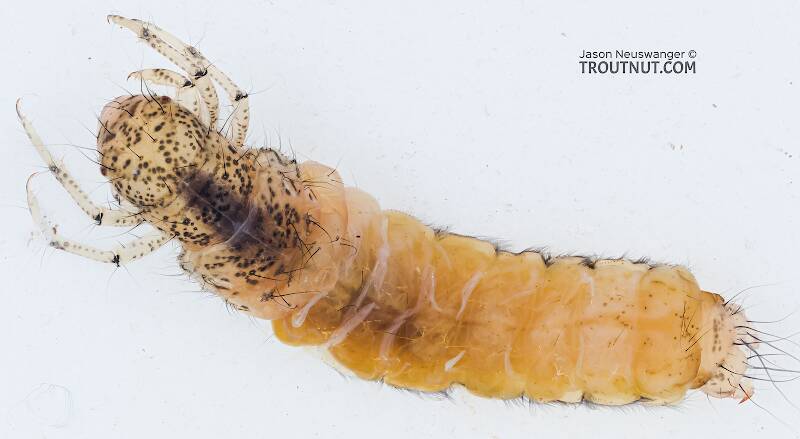
Salmonflies
Pteronarcys californica
The giant Salmonflies of the Western mountains are legendary for their proclivity to elicit consistent dry-fly action and ferocious strikes.

- The prosternal horn is present.
- The mandible is clearly toothed, not formed into a uniform scraper blade.
- The seems to be only 2 major setae on the ventral edge of the hind femur.
- Chloride epithelia seem to be absent from the dorsal side of any abdominal segments.
Based on these characteristics and the ones more easily visible from the pictures, this seems to be Grammotaulius. The key's description of the case is spot-on: "Case cylindrical, made of longitudinally arranged sedge or similar leaves," as is the description of the markings on the head, "Dorsum of head light brownish yellow with numerous discrete, small, dark spots." The spot pattern on the head is a very good match to figure 19.312 of Merritt R.W., Cummins, K.W., and Berg, M.B. (2019). The species ID is based on Grammotaulius betteni being the only species of this genus known in Washington state.

Stonefly Species Zealeuctra claasseni (Tiny Winter Blacks)
Where & when
In 32 records from GBIF, adults of this species have mostly been collected during March (41%), February (31%), April (16%), and January (6%).
Species Range
Physical description
Most physical descriptions on Troutnut are direct or slightly edited quotes from the original scientific sources describing or updating the species, although there may be errors in copying them to this website. Such descriptions aren't always definitive, because species often turn out to be more variable than the original describers observed. In some cases, only a single specimen was described! However, they are useful starting points.
Description from GBIFthe Global Biodiversity Information Facility
Source: A review of the Nearctic genus Zealeuctra Ricker (Plecoptera, Leuctridae), with the description of a new species from the Cumberland Plateau region of eastern North America
Description. Male - abdominal tergal cleft. Anterior portion V-shaped with slight inward medial swelling but lacking crenulations along inner margins, anterior terminus very narrowly rounded (Figs 3 A-D). Posterior portion slightly more U-shaped with several irregularly-sized and rounded teeth projecting medially. Male - epiproct. Triangular base narrowing to anteriorly-recurved and tapering terminal spine, no accessory spine or swelling present (Figs 3 E-H). Conspicuous tubercles located on the anterior margins of the triangular base. No accessory spine or cusp present.
Female - 7 th sternum. Seventh sternum with a small, variably-shaped lobe nested in a small central notch (Figs 3 I- 3 L). The lobe ranges in shape from somewhat quadrate to broadly convex. The notch is likewise variably shaped, from essentially straight and scarcely perceptible (Figs 3 I, 3 K) to slightly concave (Figs 3 J, 3 L). Posterior margin essentially straight.
Start a Discussion of Zealeuctra claasseni
References
- Merritt R.W., Cummins, K.W., and Berg, M.B. 2019. An Introduction to the Aquatic Insects of North America (Fifth Edition). Kendall/Hunt Publishing Company.
Stonefly Species Zealeuctra claasseni (Tiny Winter Blacks)
Species Range
Common Names
Resources
- NatureServe
- Integrated Taxonomic Information System
- Global Biodiversity Information Facility
- Described by Frison, T.H. (1929) Fall and winter stoneflies, or Plecoptera, of Illinois. Illinois Natural History Survey Bulletin 18, 345–409.

